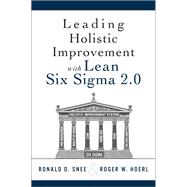Leading Holistic Improvement with Lean Six Sigma 2.0 distills all that’s been learned about Six Sigma over the past three decades, helping you build and execute on modern holistic strategies to radically improve processes and performance. It’s the definitive modern guide to Lean Six Sigma for executives, champions, Black Belts, Green Belts, and every stakeholder concerned with performance improvement. In addition, it notes the limitations of Lean Six Sigma and explains how to broaden deployments to true holistic improvement, integrating multiple improvement methodologies.
Renowned experts Ronald Snee and Roger Hoerl help you launch or accelerate comprehensive “Lean Six Sigma 2.0” initiatives, integrating modern techniques to improve customer satisfaction, employee engagement, growth, and profitability across your organization. They introduce important recent advances in Lean Six Sigma theory and practice, and offer new case studies illuminating opportunities for holistic improvement. With an ideal mix of fundamental concepts and real-world case studies, the authors help you broaden your portfolio of improvement methodologies, integrating systems for process management, control, and risk management.
This revision incorporates decades of collective experience in improvement initiatives, the most relevant research on what does and doesn’t work, and contains three completely new chapters, as well as two previously unpublished holistic improvement case studies. This innovative approach is specifically designed to help you solve large, complex, and unstructured problems; and manage risk in a world of cyberattacks, terrorism, and fragmentation.
- Plan and deploy a modern Lean Six Sigma strategy that fully reflects your organization
- Learn and apply key lessons from the world’s best implementations
- Integrate key success factors into a step-by-step process for improvement, and avoid common pitfalls that lead to failure
- Master all facets of Lean Six Sigma leadership, including strategy, goal setting, metrics, training, roles/responsibilities, processes, reporting, rewards, and ongoing management review
- Evolve your deployment to true holistic improvement that leverages modern methods and encompasses the entire organization
- Make the most of big data analytics and other modern methods
- Choose the optimal improvement method for each complex challenge you face
- Use a focus on improvement as a leadership development tool








